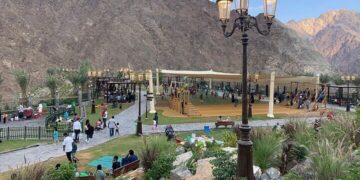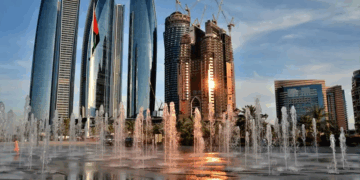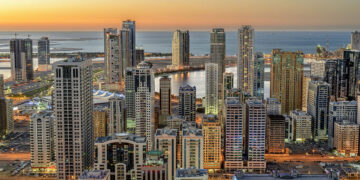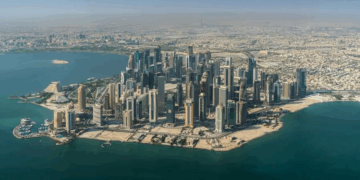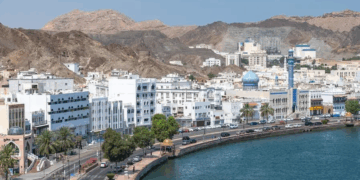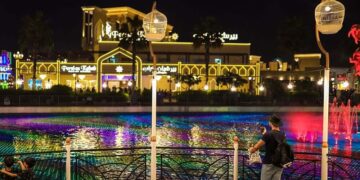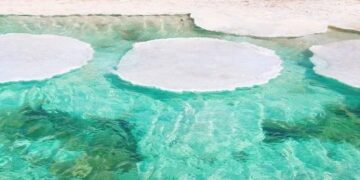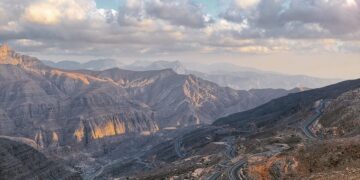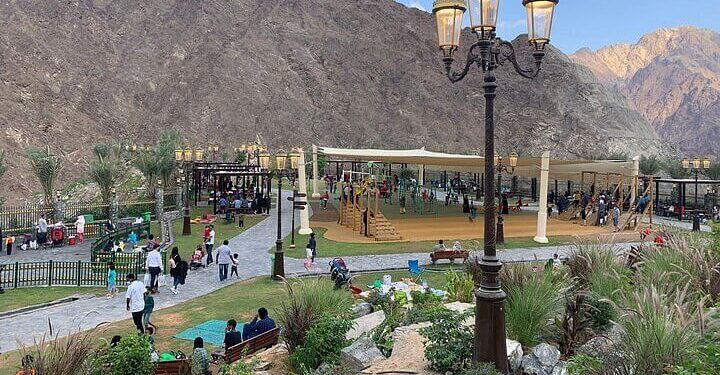When thinking of the UAE, towering skyscrapers and vast deserts often come to mind. However, have you ever considered the jagged mountain peaks and trickling streams that can be found there?
Wadi Shees, a natural oasis nestled in the emirate of Sharjah, offers a refreshing change from the typical images associated with the country. This hidden gem boasts lush green farmland and towering date palms, just a short drive away from the bustling cities of the UAE – a mere 45 minutes from Sharjah and 90 minutes from Dubai.
For those seeking a break from city life, Wadi Shees is the perfect escape. It provides a unique opportunity to explore a different side of the UAE, characterized by breathtaking natural beauty, rich history, and the chance to enjoy traditional evening gahwa.
If you’re intrigued by the idea of visiting Wadi Shees, keep reading to discover all the information you need to plan your unforgettable trip to this picturesque oasis.
The Best Time To Visit Wadi Shees
Nestled among the peaks of the Hajar mountains, Wadi Shees boasts its unique microclimate. But what does this mean exactly? Essentially, Wadi Shees enjoys cooler temperatures year-round.
Even when Dubai is sweltering in the 40s (or even 50s!), Wadi Shees remains a comfortable 32 degrees Celsius or below. This makes it an ideal destination to visit at any time of the year, with consistently mild temperatures and lush surroundings.
However, it is important to note that visiting Wadi Shees during rainy weather can be risky. Wadis are particularly susceptible to flash floods, putting visitors in danger during heavy rainfall. While rain is rare in the UAE, it is wise to reconsider your plans if you happen to choose the one rainy day of the year for your visit.
What To Bring To Wadi Shees
When visiting Wadi Shees, it is important to keep in mind that the area is still home to active farms and a small village. While exploring the area, you may come across a few locals.
Respect for local customs is crucial, so it is advisable to dress modestly. Both men and women should ensure their knees and shoulders are covered, although women are not required to cover their heads. It is best to avoid clothing such as tank tops, dresses, mini skirts, or shorts.
Comfortable shoes are essential for exploring the area. Hiking boots are not necessary; a good pair of sneakers will suffice for wandering the nature trail and discovering the surroundings.
For those planning to spend the day, Shees Park is an ideal spot for a picnic. While a few food trucks may arrive in the evening, it is recommended to bring your snacks, lunch, and plenty of water.
When engaging in outdoor activities in the UAE, it is crucial to protect yourself from the sun. Do not forget to apply sunscreen and consider wearing a hat or scarf to shield your neck from the sun’s rays.
Things To Do In Wadi Shees
Whether you are looking to enjoy a relaxing picnic in the park, take a refreshing dip in a waterfall, or simply wander through the majestic date palms, there is no shortage of activities to enjoy in this stunning region of the UAE. Below are some of the things to do in or near Wadi Shees.
1. Hike The Wadi Shees Nature Trail
The 1.8km trail we always recommend when asked about outdoor adventures in the UAE is a hidden gem. The path is relatively easy, surrounded by towering date palms and an ancient falaj system, making it ideal for both novice hikers and outdoor enthusiasts.
Located just outside the village of Shees, the trail begins next to the parking area. A large sign provides a glimpse into the history of the region, from the Naqbi Tribe’s settlement in Wadi Shees centuries ago to the preservation efforts led by the Emirate of Sharjah, with the nature trail being one of them.
Starting behind the sign, the trail leads up a series of steps to the Old Village. This village is still home to farmers working in Wadi Shees, so it’s important to respect the locals and stay on the main path. Keep an eye out for wildlife along the way!
As you walk along the nature trail, you’ll notice a water channel running alongside the path, occasionally forming larger pools. This is a falaj, an ancient irrigation system used to transport freshwater year-round.
The falaj system has been crucial in the arid climates of the Gulf for centuries, especially in a region that receives less than 200mm of rainfall annually. By utilizing gravity to transport water from underground wells, the falaj has supported farming, cooking, and drinking in the UAE.
The falaj system at Wadi Shees is a historical marvel, dating back nearly 3,000 years, making it one of the oldest in the country. Despite its age, the falaj system remains remarkably well-preserved, thanks to extensive restoration efforts in 2019 aimed at both preserving its historical significance and ensuring its practical functionality.
As you wander along the nature trail, you will have the opportunity to witness the falaj in operation, marveling at how it continues to provide fresh to the terraced farms in Wadi Shees. It is important to note that the channels and pools of the falaj are not for swimming, as they serve as a crucial water source for the area.
2. Take A Hike To The Oman Border
Wadi Shees is located right on the border of Madha, which is colloquially known as the “Oman donut.” Yes, you read that correctly – within the UAE lies a small enclave of Oman (Madha), within which lies a small enclave of the UAE (Nahwa). The result? An Oman donut.
Despite being in another country, visitors do not need a visa to enter Madha from the UAE. This means that after only a short walk from Wadi Shees, you can have your feet in two countries at the same time.
To reach the border, follow the wide gravel road out of the village of Shees until you reach the border. You may see occasional cars traveling along the road, but it is wide enough to accommodate both vehicles and hikers.
After about 1 kilometer, you will see a small white border sign to your left, located on a large rock. You will need to do a short rock scramble to reach the sign, but once you are there, you can proudly say that you have stood in two countries at once. Additionally, the views of the Hajar Mountains from this vantage point are truly breathtaking.
This road eventually leads visitors further into the enclave of Nahwa (UAE) and then into the town proper of Madha (Oman). Those with 4WD vehicles can access the enclaves from this side (West to East), but for those with 2WD vehicles, we recommend entering the enclave from the other direction (East to West).
So, why does an Oman donut exist within the UAE? The simplified story dates back to the 1930s when the ruling clans of Ras Al Khaimah, Sharjah, Fujairah, and Oman asked the Madhanis who they would like to align themselves with. While all neighboring towns chose alliances that would later become part of the UAE, the Madhanis chose Oman because their government would remain loyal to Oman, and thus the donut was born.
3. Admire The Waterfall In Shees Park
Located up the hill from the charming village of Shees, Shees Park is a must-visit destination on your journey to Wadi Shees. This picturesque park features a playground, viewing terraces, and its main attraction – a magnificent 25-meter-high waterfall flowing over the mountain’s edge.
In stark contrast to the arid brown and orange desert landscapes, Shees Park boasts lush green grass and babbling streams. Venture up to the viewpoint above the park for a breathtaking panorama of the majestic Hajar Mountains and the verdant valley of Wadi Shees.
Whether you’re beginning or concluding your exploration of the area, Shees Park is the ideal starting point. Equipped with permanent grills, it’s the perfect setting for a Friday night barbecue. If cooking isn’t your forte, a cozy cafe is available on-site, with food trucks lining up outside the gates on weekend evenings.
Due to its popularity, Shees Park tends to get crowded on Friday evenings. To secure a prime spot for your barbecue, it’s advisable to arrive early. Please be aware that camping is prohibited at Shees Park, so make sure to arrange transportation after your visit. Additionally, smoking shisha, bringing dogs, horseback riding, and hunting are strictly prohibited within the park’s premises.
4. Take A Dip In The Masafi Rain Waterfalls
One of my favorite hidden gems in the UAE is this secluded waterfall and secret swimming hole. It’s a natural falaj, with rainwater flowing through the wadi and forming small pools and waterfalls that are perfect for swimming.
The best part? It’s conveniently located right off the road to Wadi Shees, making it an ideal spot for a quick dip on your way to Shees!
To reach the waterfalls, head eastbound on S142 (Khorfakkan Road). After passing the ramp to E89 (do not take this exit!), you’ll see a gravel lot with several food vendors on your right. Pull into this lot and you’ll notice a gravel road leading down the side of the wadi to the far right.
Follow the road for about 500 meters until you reach a small parking area at the base of the wadi. The road is unpaved but well-compacted and suitable for 2WD vehicles. If you prefer not to drive down, you can park in the lot above and walk down to the wadi.
The walk to the pools takes about 10 minutes through the wadi to the left of the parking area. The terrain is relatively flat but rocky and uneven. There are a few shallow stream crossings before you reach the pools, so wear shoes that can get wet.
Upon reaching the first pool hidden under a low-hanging rock, be aware that its depth varies depending on recent rainfall. After heavy rain, you may need to swim into the cave. Inside the cave is a magical sight – light filters through the water, creating patterns on the rock walls, and a small waterfall trickles down the rocks in the corner. If the water is deep enough, it’s a great spot for cannonballs!
After enjoying the cave, head left (you may need to climb over some rocks) and venture further into the wadi, where you’ll…
5. Go Kayaking Or Hiking At Al Rafisah Dam
Just a short drive from Shees lies the Al Rafisah Dam, a stunning reservoir nestled within the peaks of the Hajar Mountains. Whether you’re seeking a leisurely afternoon or an active adventure, this destination has something for everyone. Rent a colorful kayak to explore the lake, or embark on a trek along the Al Rafisah Trail for a bird’s eye view of the dam.
Originally constructed in the 1980s, the Al Rafisah Dam has recently undergone upgrades by the Sharjah Tourism Board to promote nature tourism within the Emirate. Visitors can now enjoy amenities such as a children’s play area, a paved walking path, a small supermarket, and a restaurant serving delicious local Emirati dishes.
There are various ways to experience the lake, from kayaks to pedal boats. Check out the updated prices and timings for boat rentals to plan your visit accordingly. While any time of day is suitable for a boat ride, consider an evening paddle for a magical experience as the light dances off the turquoise waters and the air cools down.
On the right side of the dam, the Al Rafisah Trail begins its ascent up the mountain. The trail splits into two paths after crossing the dam via a walking bridge. The right path offers a short 500-meter walk along the dam’s edge, leading to a parking area and ideal for beginners.
For a more challenging hike, take the left path which winds up the mountain with breathtaking views throughout. Sturdy footwear is a must as the trail is steep and unpaved. The trek to the mountain peak is about 1 kilometer, but the trail extends further into the Hajar Mountains towards the Al Suhub Rest House.
After reaching the peak and soaking in the panoramic views, you can decide whether to return or continue on the longer hike. The Al Rafisah Dam and its surrounding trails offer a perfect blend of nature, adventure, and relaxation for all visitors.
Also Read: Here are 10 free things to do in Dubai
